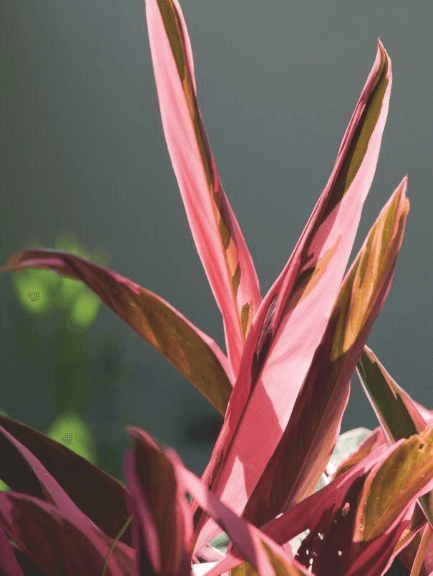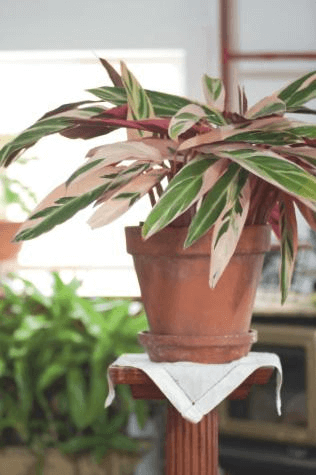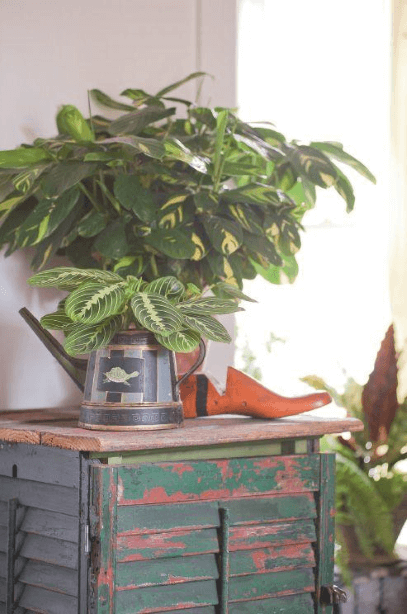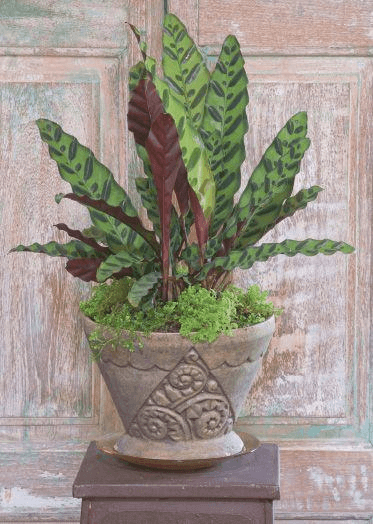[Ebook Việt hóa] The Unexpected Houseplant: 220 Extraordinary Choices for Every Spot in Your Home, Chi Calathea (Goeppertia) - Chi Đuôi Công, Chi Ctenanthe, Chi Maranta, Chi Stromanthe
[Ebook Việt Hoá] The Unexpected Houseplant: Marantas, Ctenanthes, Calatheas và Stromanthe (4 chi cây Công Cầu Nguyện)
- Nguồn: [Ebook] The Unexpected Houseplant: 220 Extraordinary Choices for Every Spot in Your Home –
- Biên tập: Dũng Cá Xinh (Tháng 02/2022)
- Dịch: Vui Nguyễn
English
MARANTAS, CTENANTHES, AND CALATHEAS
THE SUN HITS at rakish angles in autumn, training the spotlight on backstage plants that suddenly shine in the glimmerglow. There’s that moment in the early morning when I pad downstairs to find the light hitting the recesses of a dark corner where sunbeams rarely strike. For that one occasion (if I had awoken half an hour later, I would have missed it), Ctenanthe oppenheimiana ‘Tricolor’ is ignited in a conflagration of smoldering shades. I navigate the gnaw-hole-pierced electric-blue feathered birds, octopus-legged mice, and stuffed veterinarian-effigies in my path. I sidestep the furry ambush (“I don’t suppose that tail swishing behind the staghorn fern belongs to you, Einstein?”) en route to the arrow-shaped leaves on fire by a stray sunbeam at the far end of my attached, generally poorly lit greenhouse. Because it rarely blossoms in a home environment, the ctenanthe might be overlooked most of the time. But this morning, it’s a stunner.
The kitten’s hobby is shredding. He takes out orchids at regular intervals and has such a vendetta against the lavender that the hapless plant has been surrendered as sacrificial. The cissus is spaghetti. If his wrath was unleashed on the members of the genus Marantaceae in residence, there would be no justification for letting those plants linger. A marred leaf on a maranta is enough to blemish the overall picture. And most take their time sending up a replacement crop of foliage. Mercifully, Einstein is not the least bit interested in marantas. Yet.


Einstein might not agree (thankfully), but there’s something truly enthralling about this group of plants. They run the gamut from incredibly easy (I’m thinking of the prayer plant, Maranta leuconeura var. kerchoviana, with its little rabbit-track markings running down the center of oval leaves, which is featured at supermarkets far and wide) to devilishly difficult (Calathea makoyana, the humidity-demanding peacock plant, comes to mind). The middle ground is populated by plenty of truly lovely, house-worthy individuals that add to the tapestry of color in a home.
Marantas, ctenanthes, and calatheas are the best-dressed plants around. Compared to some of the other foliage standbys, like dracaenas and aglaonemas, marantas have an unparalleled sophistication. Interior designers wouldn’t hesitate to upholster a sofa with the patterns on their leaves. Most members of this family are native to tropical America; many hail from Brazil and thereabouts. Their coloration reflects that heritage.
Their native environments explain why some members of this group are tricky in our humidity-deprived, seriously not-tropical homes. Even with my menagerie of houseplants increasing the overall humidity in their close proximity, calatheas are a challenge. I consider Calathea roseapicta, C. musaica, and C. undulata to be terrarium fare only, although you can occasionally find them in garden centers (with no warning signage about their difficulty for houseplant applications). Marantas of all stripes are easier, however. And ctenanthes are somewhere in the middle. Although identification sometimes feels like splitting hairs and is classified on the basis of flower traits, I can usually tell the difference from the foliage. Marantas are all slightly different spins on the same theme of broad, paper-thin leaves with jagged, lightning bolt–like markings on their surface. They generally remain less than a foot in height. Occasionally, they have little wispy flowering spires that don’t amount to much and could be accused of distracting. Ctenanthes are taller, blossom infrequently, and bear their beautiful leaves on branching stems. And those little snobs, the difficult-to-grow calatheas, are hauntingly otherworldly, with designer-quality patterns on their thick, glossy leaves that initiate from the ground. They rarely bloom.


If my home was very dry, I would be limited to (yawn) Maranta leuconeura var. kerchoviana. But thanks to all the resident plants raising the humidity levels, I can support everything but fussy calatheas. As for cultivation, I go for a light, fluffy growing medium with plenty of leaf mold included. I’ve noticed that ctenanthes are heavy drinkers. Most of my early morning visits are followed immediately by a return with the watering can. Let a ctenanthe dry out, and in no time it will retaliate with shriveled, browning leaves. Fortunately, the whole shebang never goes sour all at once. Instead, ctenanthes signal their displeasure with a few token pleas for help in the form of leaf-edge browning.
Although it’s true that mealy bugs pester lots of plants, I find that they are drawn to marantas with almost the same sadistic vehemence as bougainvilleas. It takes a while for mealy bugs to undermine a plant, so keep a vigilant eye out for these varmints and take action quickly (while simultaneously segregating the plant). They are worth the trouble.
Maranta, Ctenanthe, and Calathea
- ALSO CALLED: never-never plant (Ctenanthe), peacock plant (Calathea), prayer plant (Maranta), ten commandments (Maranta)
| FLOWERS | Insignificant; could be accused of being distracting |
| FOLIAGE | The main attraction, with colorful, artistic markings |
| OTHER ATTRIBUTES |
Foliage can curl after dark |
| SIZE | Depending on species, 1–3 feet (30–90cm) in height |
| EXPOSURE | East or west |
| WATER REQUIREMENTS |
Heavy, but don’t overwater. Fluoride in water can cause browning leaf edges in calatheas. |
| OPTIMUM NIGHTTIME TEMPERATURE |
60–65°F (15–18°C) |
| RATE OF GROWTH | Slow |
| SOIL TYPE | Light, humusy potting soil |
| FERTILIZING | Early spring to late autumn |
| PROBLEMS | Mealy bugs |
Tiếng Việt
MARANTAS, CTENANTHES, AND CALATHEAS
ÁNH NẮNG MẶT TRỜI ngày thu nghiêng bóng, chiếu rọi lên những cái cây ở phía sau, bất ngờ khiến chúng tỏa sáng lấp lánh. Đó là khoảnh khắc vào một buổi sớm khi tôi đi xuống cầu thang để tìm kiếm nguồn sáng chiếu vào một góc tối nơi chúng hiếm khi xuất hiện. Lần đó (nếu tôi thức dậy muộn nửa tiếng, tôi đã bỏ lỡ khung cảnh này), Ctenanthe oppenheimiana ‘Tricolor’ bừng sáng trong một đám cháy đang âm ỉ. Tôi dẹp gọn những thứ trên đường đi sang một bên. Tôi tránh né cuộc phục kích của thứ gì đó đầy lông lá (“ Anh bạn nghĩ rằng tôi không biết cái đuôi đang vắt sau cây dương xỉ sừng hươu là của bạn anh bạn sao, Einstein?”) Trên đường tới với những chiếc lá hình mũi tên đang sáng rực dưới tia nắng mặt trời đi lạc ở đầu xa của căn nhà, nói chung đó là nhà kính chiếu sáng kém. Bởi vì chúng hiếm khi nở trong môi trường nhà ở, nên hầu hết thời gian, Ctenanthe đều bị bỏ qua. Nhưng sáng nay, nó khiến tôi kinh ngạc.
Sở thích của mèo con là cắn xé mọi thứ. Einstein thích lôi hoa lan trong giỏ ra và gặm cắn chúng, như có thù oán với hoa oải hương, nó vần vũ đến nỗi loài thực vật bất khả chiến bại này đã không thể sống sót. Chi Hồ đằng (Cissus) là mì Ý. Nếu cơn thịnh nộ của anh ta trút lên những thành viên của chi Marantaceae, sẽ không có lý do gì để biện minh cho việc giữ những loài thực vật đó ở đây. Một chiếc lá hoen ố trên cây Maranta đã đủ làm xấu đi bức tranh tổng thể. Và sẽ mất rất nhiều thời gian nếu cứ thay thế mãi các tán lá của cây. Thật may, Einstein không quan tâm đến Marantas lắm.


Einstein có thể không đồng ý (rất may), nhưng có điều gì đó thực sự khiến nhóm thực vật này làm ta say mê. Từ những cây dễ trồng (tôi đang nghĩ đến cây Cầu nguyện, Maranta leuconeura var. Kerchoviana, với những đường vân hình con thỏ nhỏ chạy dọc giữa các lá hình bầu dục) cho đến những cây khó kinh khủng (Calathea makoyana, loài cây đuôi công ưa ẩm). Khu đất trung tâm có rất nhiều cây đáng yêu, chúng làm tăng thêm màu sắc cho ngôi nhà.
Marantas, ctenanthes và calatheas là những loài thực vật “mặc đẹp nhất”. So với một số loại hoa có tán khác, như Huyết dụ (Dracaenas) và aglaonemas, marantas vô cùng tinh tế. Các nhà thiết kế nội thất sẽ không ngần ngại chọn bộ sofa có những họa tiết trông giống chúng. Hầu hết các thành viên trong họ này có nguồn gốc từ châu Mỹ nhiệt đới; một số đến từ Brazil và vùng lân cận. Màu sắc của chúng cũng phản ánh nguồn gốc đó.
Môi trường bản địa của chúng giải thích lý do tại sao một số thành viên trong nhóm này lại khó sống trong những ngôi nhà thiếu độ ẩm, hay không phải vùng nhiệt đới. Ngay cả khi hàng loạt cây trồng trong nhà làm tăng độ ẩm tổng thể trong những khu vực gần chúng, thì đó vẫn là một thách thức với Calathea. Tôi coi Calathea roseapicta, C. musaica, và C. undulata là loại cây chỉ trồng trong terrarium, mặc dù đôi khi bạn có thể tìm thấy chúng ở các trung tâm làm vườn (không có biển cảnh báo về độ khó của chúng khi trồng trong nhà). Tuy nhiên, Marantas có sọc dễ dàng chăm sóc hơn. Và Ctenanthes thì trung bình. Mặc dù việc nhận dạng đôi khi rất khó khăn và được phân loại dựa trên các đặc điểm của hoa, nhưng tôi thường phân biệt được sự khác biệt đến từ các tán lá. Các vòng xoáy của Marantas nằm ở giữa những chiếc lá rộng, mỏng như giấy với những vết răng cưa, giống như tia chớp trên bề mặt lá. Nhìn chung, chúng chỉ cao chưa đến 30cm. Đôi khi, chúng không có nhiều những ngọn hoa nhỏ do đó nó không gây mất tập trung. Ctenanthes cao hơn, ra hoa không thường xuyên, những chiếc lá xinh xắn mọc trên những thân cây không phân nhánh. Và những cây Calathea nhỏ bé, khó phát triển, với những chiếc lá dày, bóng bắt đầu mọc lên từ mặt đất. Chúng hiếm khi nở hoa.


Nếu không khí trong nhà tôi khô, tôi sẽ hạn chế trồng Maranta leuconeura var. kerchoviana. Nhưng nhờ tất cả các loài thực vật đang cư trú tại đây giúp nâng cao độ ẩm, tôi có thể trồng mọi thứ, trừ những cây khó tính. Đối với việc trồng trọt, tôi chọn đất trồng nhẹ, xốp với nhiều nấm mốc. Tôi nhận thấy rằng Ctenanthe là những kẻ nghiện nước nặng. Đa số các chuyến thăm vào buổi sáng sớm của tôi thường kèm theo ngay sau đó là việc quay trở lại với một bình nước. Nếu không tưới nước cho Ctenanthe, chẳng bao lâu nữa nó sẽ trả thù bạn bằng những chiếc lá héo úa. May mắn thay, những dấu hiệu này sẽ không xảy ra ngay. Thay vào đó, chúng cho thấy sự không hài lòng bằng một vài lời cầu xin sự giúp đỡ dưới dạng những đốm màu nâu ở mép lá.
Mặc dù đúng là rệp sáp làm hại rất nhiều cây trồng, tôi thấy rằng chúng cũng tàn phá Marantas với sự kịch liệt và bạo lực như ở chi Hoa giấy (Bougainvilleas). Rệp sáp phải mất một thời gian dài để phá hoại cây trồng, vì vậy hãy chú ý theo dõi những loài bọ xít này và hành động nhanh chóng (đồng thời cách ly cây). Chúng sẽ gây ra nhiều rắc rối đấy.
Maranta, Ctenanthe, and Calathea
- CÒN GỌI LÀ: cây never-never (Ctenanthe), cây Đuôi công (Calathea), cây Cầu nguyện (Maranta), cây mười điều răn (Maranta)
| HOA | bình thường; gây mất tập trung |
| LÁ | điểm thu hút chính là những hoa văn đầy nghệ thuật và nhiều màu sắc trên lá |
| THUỘC TÍNH KHÁC | lá sẽ bị xoăn nếu quá tối |
| KÍCH THƯỚC | Tùy vào từng loài, cao từ 1–3 feet (30–90cm) |
| ÁNH SÁNG | đông hoặc tây |
| YÊU CẦU VỀ NƯỚC | nhiều, nhưng không quá mức cho phép. Florua trong nước có thể gây nên hiện tượng hóa nâu ở mép lá đối với Calatheas |
| NHIỆT ĐỘ TỐI ƯU BAN ĐÊM | 60–65°F (15–18°C) |
| TỐC ĐỘ PHÁT TRIỂN | chậm |
| LOẠI ĐẤT | đất trồng chậu xốp, nhiều mùn |
| BÓN PHÂN | đầu xuân đến cuối thu |
| VẤN ĐỀ | rệp sáp |
![[Ebook Việt Hoá] The Unexpected Houseplant: Marantas, Ctenanthes, Calatheas và Stromanthe (4 chi cây Công Cầu Nguyện) [Ebook Việt Hoá] The Unexpected Houseplant: Marantas, Ctenanthes, Calatheas và Stromanthe (4 chi cây Công Cầu Nguyện)](https://vn1.vdrive.vn/codai.net/2021/02/ebook-viet-hoa-220-lua-chon-cay-canh-trong-nha-calatheas.jpg)


